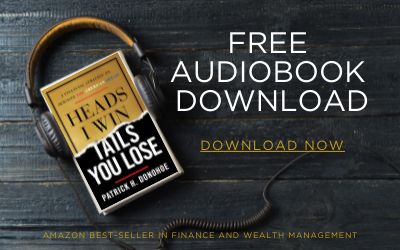Every financial decision comes with a trade-off. Have you ever purchased something and later realized that the money could have been used for something more valuable? This is called opportunity cost, and it plays a critical role in how wealth is built—or lost—over time.
Many people focus only on where to invest their money, but the wealthiest individuals, including Warren Buffett, understand that how money is positioned and utilized is just as important. Rather than letting cash sit idle, they use financial strategies that allow their wealth to work in multiple places at once.
At Paradigm Life, we teach clients how to apply this principle through The Perpetual Wealth Strategy™, a system designed to eliminate opportunity cost, maximize financial efficiency, and build long-term wealth.

What Is the Opportunity Cost?
Opportunity cost is the hidden cost of financial decisions—the trade-off between using money one way vs. investing it for greater returns. Every time you spend money, you are forfeiting the potential growth it could have generated elsewhere.
For example:
- Buying a luxury car with cash : That money is no longer available for investments that could generate passive income.
- Financing a major purchase through a traditional lender : This may result in high-interest payments, reducing cash flow and financial flexibility.
The wealthy think differently. Instead of choosing either spending or investing, they use strategies that allow them to do both at the same time.
How Opportunity Cost Affects Long-Term Wealth
Most people unknowingly lose wealth over time by not considering opportunity cost in their decisions. Some common examples include:
- Paying cash for major purchases : While it avoids debt, it also locks money into a depreciating asset instead of allowing it to compound over time.
- Keeping money in low-interest savings accounts : Traditional banks offer minimal returns, meaning purchasing power declines due to inflation.
- Relying on financial planners who only focus on traditional investments : Many advisors recommend stocks, bonds, and mutual funds but overlook strategies that maximize financial efficiency and liquidity.
How Warren Buffett Uses Opportunity Cost to His Advantage
The 1971 Vacation Home Decision
In 1971, Warren Buffett had a choice to make—one that would highlight the power of opportunity cost and long-term financial strategy. He had $150,000 available and faced two options:
- Pay cash for a vacation home : This would eliminate debt but tie up his capital in a single-use asset.
- Finance the home and invest in Berkshire Hathaway stock : This would allow his money to continue working for him while still acquiring the property.
Buffett chose the second option, using leverage to finance the home while investing the $150,000 in Berkshire Hathaway stock. The outcome?
- He still acquired and enjoyed the vacation home.
- His investment in Berkshire Hathaway grew to over $750 million.
This decision exemplifies how the wealthy think differently about money. Instead of locking up capital in an asset that doesn’t generate returns, Buffett ensured his money remained in motion, compounding over time.
Key Lessons from Buffett’s Decision
1. Leverage Capital Wisely
Many people assume paying cash is always the best option, but doing so often eliminates the ability to grow wealth elsewhere. Buffett understood that:
- Holding onto cash-flowing assets creates more opportunities.
- Investing money in appreciating assets generates compounding returns.
- Using smart financial strategies allows for both security and growth.
2. Avoid Single-Use Assets
Most people tie up money in depreciating or non-cash-flowing assets, such as:
- Cars
- Primary residences
- Vacation homes
While these purchases can provide value, they should not come at the expense of financial growth. Instead, positioning money in income-producing or appreciating investments ensures long-term financial security.
3. Use Financial Vehicles That Let Money Work in Multiple Places
Buffett’s decision to finance the vacation home and invest his capital elsewhere mirrors a strategy the wealthy use to reduce opportunity cost. This approach is similar to The Perpetual Wealth Strategy™, which leverages Whole Life Insurance to:
- Grow cash value tax-free while keeping funds accessible.
- Borrow against cash value to fund investments or major purchases.
- Ensure capital is always compounding, rather than being locked away.
Instead of making either-or financial choices, the right strategy allows money to work in multiple places at once.
The Biggest Wealth Mistakes That Destroy Opportunity Cost
Many people unknowingly lose wealth by making financial decisions that trap their money instead of letting it grow. Understanding opportunity cost—the potential gains lost when choosing one option over another—is critical to building and maintaining wealth.
Here are three common mistakes that destroy opportunity cost and how to avoid them.
1. Paying Cash for Major Purchases
Most people believe that paying cash is the best way to avoid debt, but in reality, it can limit financial growth and eliminate future opportunities.
- Why This Is a Mistake
- Using cash for big purchases drains liquidity, leaving you with less capital to invest.
- Once money is spent, it stops working for you, removing the chance for compounding growth.
- Example: Buying a Car with Cash vs. Financing While Investing
- Paying cash : The money is gone, and the car depreciates over time.
- Financing and investing the cash : Instead of paying upfront, you finance at a low rate and invest the excess funds in a high-growth asset.
- The Smarter Approach
- Use Whole Life Insurance with high cash value to fund major purchases.
- Borrow against your policy while your cash value continues to grow.
- Keep your money working in two places at once, similar to Warren Buffett’s strategy.
2. Keeping Money in Low-Interest Bank Accounts
Traditional savings accounts, CDs, and money market funds provide minimal returns, often failing to outpace inflation.
- Why This Is a Mistake
- The average savings account earns less than 1% interest, while inflation historically averages 2-3% per year.
- Keeping large sums in these accounts reduces purchasing power over time.
- What Wealthy Individuals Do Differently
- Instead of letting money sit idle, the wealthy position their cash in assets that provide both growth and liquidity, such as:
- Whole Life Insurance cash value : Earns guaranteed interest and grows tax-free.
- Income-generating real estate : Provides cash flow while appreciating over time.
- Private lending or alternative investments : Offers higher returns than traditional banking options.
- The Smarter Approach
- Instead of stockpiling cash in low-yield accounts, store wealth in Whole Life Insurance where it earns steady, compounding interest.
- Use policy loans when liquidity is needed rather than withdrawing from savings.
3. Relying on Traditional Lending
Most people turn to banks and credit lenders when they need financing for major purchases, investments, or emergencies. But these loans often come with high interest rates and restrictive terms, limiting financial flexibility.
- Why This Is a Mistake
- Bank loans come with strict repayment schedules, which can put a strain on cash flow.
- High-interest rates mean paying more over time, reducing the ability to invest in wealth-building assets.
- Credit checks and lender approvals make financing dependent on external factors.
- The Smarter Approach: Using Policy Loans from Whole Life Insurance
- Borrow against your cash value instead of relying on traditional banks.
- No credit checks or lender approvals required.
- Repay on your own terms, keeping financial control in your hands.
- Your cash value continues to grow, even while the loan is in use.
How The Perpetual Wealth Strategy™ Applies Buffett’s Principles
Warren Buffett’s success isn’t just about picking stocks—it’s about positioning money to grow while minimizing risk. The Perpetual Wealth Strategy™ follows the same principles, helping individuals build wealth strategically while avoiding opportunity cost.
Unlike traditional investments that force you to choose between saving or investing, this strategy uses Whole Life Insurance to keep your money working in multiple places at once.
1. Whole Life Insurance as an “AND” Asset
Most people think they have to choose:
- Save for the future or invest now.
- Keep money in a bank account or put it in the market.
- Buy a home in cash or finance it and invest the difference.
The wealthy don’t make these either-or decisions. They use Whole Life Insurance as an “AND” asset, allowing their money to do both at the same time.
How Whole Life Insurance Maximizes Wealth
- Earn guaranteed interest while keeping cash accessible.
- Borrow against cash value for investments, real estate, or business expenses.
- Maintain financial protection while continuing to build wealth.
Instead of locking money away, you can grow it and use it at the same time.
2. Using Policy Loans to Invest While Your Money Still Grows
When the wealthy need capital for investments, real estate, or business growth, they don’t drain their savings. Instead, they borrow against their Whole Life Insurance cash value.
How Policy Loans Work
- Your cash value stays intact and keeps earning dividends, even when borrowed against.
- No strict repayment schedule—you control when and how you pay it back.
- No credit checks or lender approvals—you access funds on your terms.
Why This Strategy Works
- Instead of pulling money from a savings account (where it stops earning interest), your policy keeps compounding wealth.
- Unlike bank loans, policy loans don’t require fixed payments, giving you more financial flexibility.
- You stay in control instead of relying on traditional lenders.
This allows you to invest in cash-flowing assets while keeping your money growing in multiple places at once—just like Buffett.
3. Creating a Volatility Buffer to Protect Wealth
Traditional investments like stocks and real estate rise and fall with the market. A sudden downturn can force investors to sell assets at a loss just to cover expenses.
The wealthy avoid this by using Whole Life Insurance as a volatility buffer.
Why Whole Life Insurance Provides Stability
- Cash value is not affected by market downturns : Unlike stocks, it grows at a guaranteed rate.
- Provides liquidity during economic uncertainty : Instead of selling investments at a loss, policyholders use their cash value for expenses or new opportunities.
- Acts as a financial safety net : If investments decline, cash value remains available for emergency funding.
How a Volatility Buffer Protects Retirement Income
For retirees, a stock market downturn can be devastating. If they sell investments at a low point to cover expenses, they lock in losses.
- Retirees can withdraw funds from their cash value during downturns, giving their stock investments time to recover.
- This ensures financial stability regardless of market conditions.
Applying Buffett’s Strategy to Your Own Finances
Warren Buffett built his fortune by eliminating opportunity cost. Instead of locking money in single-use assets, he positioned it to grow, compound, and remain accessible.
At Paradigm Life, The Perpetual Wealth Strategy™ helps individuals apply these same principles to maximize financial control and long-term wealth.
Take the Next Step
Want to see how The Perpetual Wealth Strategy™ can help you eliminate opportunity cost and build lasting wealth like Warren Buffett? Schedule a free strategy session with a Paradigm Life Wealth Strategist today.







